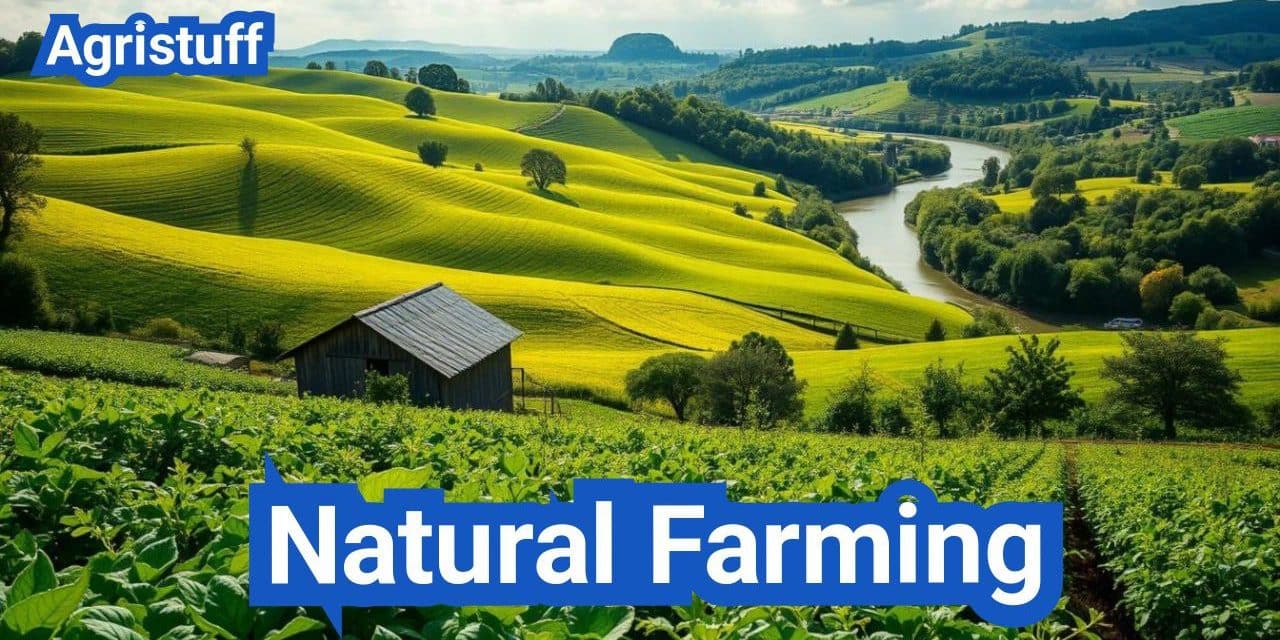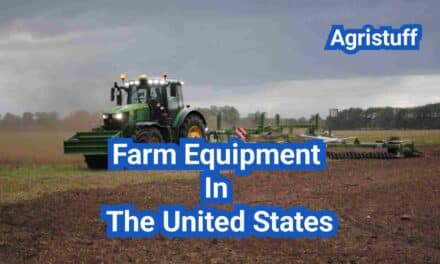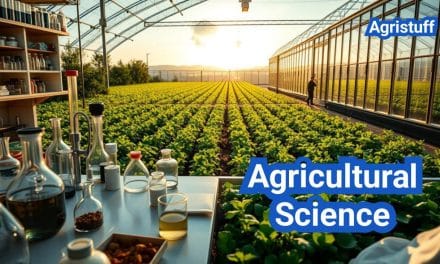Eco-friendly farming methods are gaining popularity as people become more aware of the importance of sustainable agriculture. Natural farming is an approach that avoids the use of chemical fertilizers and pesticides, promoting a healthier environment and producing nutritious food.
At its core, natural farming is about working with nature, not against it. This method focuses on using natural processes to maintain soil fertility and control pests, thereby reducing the environmental impact of farming.
Key Takeaways
- Natural farming avoids chemical fertilizers and pesticides.
- It promotes sustainable agriculture and eco-friendly practices.
- This approach enhances soil fertility naturally.
- It produces healthier food and supports biodiversity.
- Natural farming is a step towards a more sustainable future.
What Is Natural Farming?
The essence of natural farming lies in its emphasis on natural processes and biodiversity. This approach to agriculture seeks to minimize human intervention and instead, works in harmony with the natural environment.
Definition and Core Philosophy
Natural farming is defined by its core philosophy of working with nature, rather than against it. This involves adopting practices that enhance biodiversity, improve soil health, and promote ecological balance. The core philosophy is centered around the idea that nature has its own way of functioning, and farming should align with these natural processes.
Key principles include minimizing the use of external inputs, such as synthetic fertilizers and pesticides, and instead, relying on natural processes to maintain soil fertility and control pests.
Historical Development and “Do Nothing” Farming
The concept of natural farming has its roots in the work of Masanobu Fukuoka, a Japanese farmer and philosopher who pioneered the “do nothing” farming approach. Fukuoka’s method involves minimal intervention in the farming process, allowing nature to take its course. This approach has been influential in shaping the natural farming movement globally.
Do nothing farming is not about abandoning farming practices altogether but rather about understanding and working with the natural ecosystem. It emphasizes the importance of observation and minimal intervention, allowing the natural balance to be maintained.
The Principles of Natural Farming

At its core, natural farming operates on a set of principles designed to work in concert with natural processes. This approach to agriculture is characterized by a deep respect for the land and its inherent ecological balance.
No-Till Cultivation
One of the foundational principles of natural farming is no-till cultivation. This method avoids disturbing the soil through tilling, which can damage soil structure and disrupt its ecosystem. By not tilling, the soil’s natural habitat is preserved, allowing it to retain moisture and support a diverse range of microbial life.
No Chemical Inputs
Another key principle is the exclusion of chemical inputs. Natural farming rejects the use of synthetic fertilizers and pesticides, which can harm beneficial organisms and degrade soil health over time. Instead, farmers use natural alternatives to promote soil fertility and control pests.
Working With Nature’s Cycles
Natural farming also emphasizes working with nature’s cycles. This involves understanding and aligning farming practices with the natural rhythms of the ecosystem. For example, farmers might use jeevamruth, a liquid fertilizer made from cow dung and urine, to promote soil health, as practiced by Viswamatha Farms. By working in harmony with nature, farmers can create a more resilient and productive agriculture system.
This approach not only enhances biodiversity but also contributes to a more sustainable food system. By adopting these principles, natural farming offers a viable alternative to conventional agricultural methods.
Different Natural Farming Approaches
Natural farming encompasses a variety of approaches, each with its unique philosophy and methodology. These diverse methods share a common goal: to work in harmony with nature rather than controlling it. This section explores some of the most influential natural farming practices around the world.
Masanobu Fukuoka’s One-Straw Revolution
Masanobu Fukuoka’s One-Straw Revolution is a seminal work in the natural farming movement. Fukuoka’s approach emphasizes minimal intervention, advocating for no-till, no-chemical, and no-pesticide practices. His method involves:
- Leaving crop residues on the field
- Using straw to mulch and protect the soil
- Creating a diverse ecosystem
This approach not only reduces labor but also enhances soil health and biodiversity.
American Natural Farming Practices
In the United States, natural farming practices have gained popularity as farmers seek more sustainable methods. American natural farming often involves:
- Using cover crops to improve soil health
- Implementing integrated pest management techniques
- Focusing on biodiversity and ecosystem services
These practices aim to reduce the environmental impact of farming while maintaining productivity.
Community Managed Natural Farming
Community Managed Natural Farming (CMNF) is an approach that empowers local communities to take charge of their farming practices. CMNF involves:
- Training farmers in natural farming techniques
- Promoting the use of locally available resources
- Fostering community-led extension services
This approach has been successful in various parts of the world, enhancing food security and sustainability at the community level.
In conclusion, the diversity of natural farming approaches reflects the creativity and resilience of farmers worldwide. By learning from these different methods, we can develop more effective and sustainable farming practices.
Getting Started With Natural Farming

Natural farming begins with a thorough assessment of your available resources and land conditions. This foundational step is crucial for determining the most effective approach to natural farming on your land. As Masanobu Fukuoka, a pioneer of natural farming, once said, “The ultimate goal of farming is not the growing of crops, but the cultivation and perfection of human beings.” This philosophy underscores the importance of aligning your farming practices with natural principles.
Assessing Your Land and Resources
Before you start, it’s essential to assess your land’s climate, soil type, and existing ecosystem. This involves observing the natural flora and fauna, understanding the local climate patterns, and identifying any potential challenges or opportunities. Soil testing can provide valuable insights into its nutrient content and structure, helping you make informed decisions about crop selection and soil management.
Planning Your Natural Farm Layout
Once you have assessed your land, the next step is to plan your farm layout. This involves deciding on the most suitable areas for different crops, designing pathways, and potentially creating zones for specific farming activities. Consider implementing permaculture principles to maximize biodiversity and efficiency. A well-planned layout not only enhances productivity but also contributes to a more sustainable farming system.
Initial Preparation Steps
With your plan in place, you can begin the initial preparation steps. This may include clearing the land of debris, preparing the soil through non-till methods, and acquiring the necessary natural farming equipment and tools. It’s also important to start small and gradually scale up your operations as you gain experience.
“The best way to get started is to quit talking and begin doing.” – Walt Disney
This quote encapsulates the proactive approach required for successful natural farming.
By following these steps and maintaining a commitment to natural farming principles, you can create a thriving and sustainable agricultural system.
Essential Natural Farming Methods
Natural farming encompasses a range of techniques that work in harmony with nature to promote soil health, biodiversity, and efficient water use. These methods are crucial for sustainable agriculture and environmental stewardship.
Seed Balls and Natural Seeding Techniques
Seed balls, also known as earth balls or kuro-dama, are a natural seeding technique popularized by Masanobu Fukuoka, a pioneer of natural farming. This method involves mixing seeds with clay and soil to create small balls that can be scattered in the field. As the clay protects the seeds from birds and rodents, the seeds germinate when the conditions are favorable, reducing the need for manual planting.
Benefits of Seed Balls:
- Reduced labor for seeding
- Protection of seeds from predators
- Improved germination rates in suitable conditions
Green Manure and Cover Crops
Green manure and cover crops are vital components of natural farming. These crops are grown not for harvest but to improve soil health. They help in suppressing weeds, enhancing soil structure, and increasing nutrient content. Leguminous cover crops, for instance, fix atmospheric nitrogen, reducing the need for synthetic fertilizers.
Key advantages include:
- Enhanced soil fertility
- Improved soil structure
- Effective weed suppression
Indigenous Microorganism Cultivation
Indigenous microorganism cultivation is a technique used in natural farming to promote soil health. This involves collecting and cultivating native microorganisms from the farm environment and applying them to the soil. These microorganisms play a crucial role in decomposing organic matter, solubilizing minerals, and improving soil structure.
Benefits of Indigenous Microorganism Cultivation:
- Enhanced soil biodiversity
- Improved nutrient cycling
- Boosted plant health and resilience
By incorporating these essential natural farming methods, farmers can create a more sustainable and productive agricultural system that works in harmony with nature.
Soil Management in Natural Farming

Effective soil management is crucial in natural farming, focusing on enhancing soil health without disrupting its natural structure. This approach ensures that the soil remains fertile and productive over the long term, supporting biodiversity and ecosystem services.
Building Soil Health Without Tilling
Building soil health without tilling is a fundamental principle of natural farming. Tilling can damage soil structure, disrupt soil biota, and lead to erosion. Instead, natural farmers use techniques like mulching and cover cropping to enhance soil health. These methods help in maintaining soil organic matter, improving soil structure, and promoting beneficial microbial activity. For instance, Viswamatha Farms uses practices that enhance soil health, demonstrating the effectiveness of natural farming methods.
By not tilling the soil, farmers can preserve soil organic matter and reduce erosion. This approach also promotes soil biota, which is essential for nutrient cycling and overall soil fertility. As a result, the soil becomes more resilient and productive, supporting healthy plant growth.
Creating On-Farm Natural Fertilizers
Creating on-farm natural fertilizers is another key aspect of soil management in natural farming. Farmers can produce natural fertilizers like jeevamruth, a liquid fertilizer made from cow dung and urine, which is rich in beneficial microorganisms. This practice not only reduces the need for external inputs but also enhances soil fertility and promotes healthy plant growth.
On-farm natural fertilizers like jeevamruth are effective in providing nutrients to plants while improving soil health. By using such natural fertilizers, farmers can maintain soil fertility, support biodiversity, and ensure sustainable agricultural practices.
Seasonal Considerations and Crop Selection

Understanding seasonal considerations is crucial for effective crop selection in natural farming. Farmers must align their agricultural practices with the natural cycles and conditions of each season to maximize yields and maintain soil health.
Planning Diverse Crop Rotations
One of the key strategies in natural farming is planning diverse crop rotations. This approach not only promotes soil health and biodiversity but also helps in managing pests and diseases naturally. By rotating crops, farmers can break disease and pest cycles, improve soil nutrient profiles, and increase the overall resilience of their farming systems.
| Crop | Season | Benefits |
|---|---|---|
| Legumes | Spring | Nitrogen fixation, soil health improvement |
| Cereals | Summer | Soil erosion control, nutrient uptake |
| Brassicas | Fall | Pest control, soil conditioning |
Adapting to Local Climate Patterns
Adapting to local climate patterns is another critical aspect of successful natural farming. This involves understanding the local microclimate, including temperature fluctuations, rainfall patterns, and potential extreme weather events. By selecting crops that are well-suited to the local climate conditions, farmers can reduce the need for external inputs and create a more sustainable farming system.
By carefully planning crop rotations and adapting to local climate patterns, natural farmers can create resilient and productive farming systems that work in harmony with nature.
Water Conservation and Management

Water conservation is a cornerstone of sustainable natural farming. Effective management of water resources is crucial for maintaining healthy crops, supporting biodiversity, and ensuring the overall resilience of the farming system.
One of the key strategies for water conservation in natural farming is the implementation of rainwater harvesting systems. These systems collect and store rainwater for use during dry periods, reducing reliance on external water sources.
Rainwater Harvesting Systems
Rainwater harvesting involves the collection of rainwater from rooftops or other surfaces and storing it in tanks or reservoirs. This technique not only conserves water but also helps in recharging groundwater.
Benefits of Rainwater Harvesting:
- Reduces water bills by providing an alternative source of water.
- Decreases stormwater runoff, thereby reducing erosion and improving water quality.
- Provides a reliable source of water during droughts or water restrictions.
Minimal Water Usage Techniques
In addition to rainwater harvesting, natural farmers employ various techniques to minimize water usage. These include mulching, drip irrigation, and planting drought-resistant crops.
By adopting these strategies, natural farmers can significantly reduce their water footprint while maintaining productive and sustainable farming systems.
Natural Pest and Disease Management

Natural farming relies heavily on balanced ecosystems to manage pests and diseases naturally. This approach not only ensures the health of crops but also contributes to the overall biodiversity of the farm.
Creating Balanced Ecosystems
Creating balanced ecosystems is a multifaceted approach that involves promoting biodiversity and ensuring that the farm ecosystem is resilient. This can be achieved by:
- Planting a diverse range of crops to attract beneficial insects and pollinators.
- Maintaining soil health through the use of organic amendments and minimal disturbance.
- Incorporating native plants and flowers that provide habitat for beneficial organisms.
By fostering a balanced ecosystem, natural farmers can reduce the incidence of pests and diseases, creating a more sustainable and productive farming system.
Natural Pest Control Solutions
In addition to creating balanced ecosystems, natural farmers employ various natural pest control solutions. These include:
- Using biological controls such as introducing beneficial insects that prey on pests.
- Applying natural substances like neem oil or diatomaceous earth to control pest populations.
- Practicing crop rotation and intercropping to break pest cycles.
These methods not only help in managing pests but also contribute to the overall health of the ecosystem, ensuring a balanced and sustainable farming practice.
Natural Farming vs. Other Sustainable Approaches

In the realm of sustainable agriculture, natural farming is often compared to other methods like organic farming and permaculture. While these approaches share the common goal of reducing environmental impact, they differ in their philosophies and practices.
Comparing Natural and Organic Farming
Natural farming and organic farming are often confused with one another due to their shared emphasis on avoiding synthetic chemicals. However, natural farming takes a more holistic approach by not just avoiding chemicals but also minimizing intervention in the natural ecosystem. Organic farming, on the other hand, focuses on using natural alternatives to synthetic fertilizers and pesticides, often still relying on tilling and external inputs.
A key difference lies in their approach to soil health. Natural farming promotes soil health through non-tillage and the use of indigenous microorganisms, whereas organic farming may still use tillage and relies on approved organic fertilizers.
| Aspect | Natural Farming | Organic Farming |
|---|---|---|
| Tillage | No-till or minimal tillage | May use tillage |
| Soil Health | Indigenous microorganisms, no external inputs | Approved organic fertilizers, may use external inputs |
| Chemical Use | Avoids synthetic chemicals | Avoids synthetic chemicals, uses natural alternatives |
Natural Farming vs. Permaculture
Permaculture is a design system that aims to create sustainable ecosystems by mimicking nature. While natural farming shares the goal of working with nature, it differs in its focus on minimal intervention. Permaculture often involves designing complex systems that include multiple crops and animals, whereas natural farming tends to focus on crop cultivation with minimal external inputs.
Natural Farming vs. Biodynamic Agriculture
Biodynamic agriculture is a holistic approach that views the farm as a living organism. It incorporates spiritual and mystical elements, such as lunar cycles, into farming practices. Natural farming, while also holistic, focuses more on the principle of non-intervention and working with nature’s rhythms without the spiritual dimensions.
A comparison of these sustainable farming methods reveals that while they share common goals, their approaches and philosophies differ significantly. Understanding these differences is crucial for farmers and consumers alike to make informed decisions about sustainable agriculture.
Equipment and Tools for Natural Farming

Effective natural farming requires a thoughtful selection of equipment and tools that work in harmony with nature. The right tools not only enhance productivity but also ensure that the farming practices remain sustainable and environmentally friendly.
Essential Hand Tools and Equipment
For small-scale natural farming, hand tools are indispensable. They allow farmers to cultivate, plant, and harvest without the need for extensive mechanization. Essential hand tools include hoes for weeding, forks for turning soil, and rakes for leveling ground. These tools are not only cost-effective but also provide a direct connection to the land, allowing farmers to observe and respond to the needs of their crops and soil.
Appropriate Technology for Larger Operations
As natural farming operations scale up, the use of appropriate technology becomes more significant. This can include simple machinery like seed drills and cultivators that are designed to work with the principles of natural farming, minimizing soil disturbance and preserving soil health. The key is to adopt technology that complements the natural farming methodology, enhancing efficiency without compromising the ecological balance.
By carefully selecting the right natural farming equipment and tools, farmers can ensure the long-term viability and productivity of their land. Whether using hand tools for small plots or appropriate technology for larger areas, the focus remains on maintaining a harmonious relationship between farming practices and the natural environment.
Economic Viability of Natural Farming

As natural farming continues to grow, its economic benefits are becoming increasingly apparent. This approach to farming not only promotes environmental sustainability but also offers a viable economic alternative to conventional farming methods.
Cost-Benefit Analysis
One of the primary economic advantages of natural farming is the reduction in input costs. By avoiding synthetic fertilizers and pesticides, farmers can significantly lower their expenses. Additionally, natural farming often involves the use of locally available resources, further reducing costs. A cost-benefit analysis typically reveals that the savings from reduced chemical inputs can offset the initial investment in transitioning to natural farming practices.
Marketing Natural Farm Products
Marketing natural farm products effectively is crucial for their economic viability. Consumers are increasingly willing to pay a premium for products that are sustainably produced, making natural farm products highly marketable. Farmers can leverage this trend by adopting transparent labeling and certification processes, such as organic or regenerative agriculture labels, to build trust with their customers.
By focusing on the unique selling points of natural farm products, such as their environmental benefits and high quality, farmers can successfully market their produce and achieve a competitive edge in the market.
The Future of Natural Farming
Natural farming has emerged as a vital component of sustainable agriculture, offering a promising path forward for farmers and the environment. By embracing the principles of natural farming, farmers can improve their livelihoods while promoting ecological balance.
The future of natural farming looks bright, with its potential to transform the agricultural landscape. As more farmers adopt natural farming practices, the benefits of this approach will become increasingly evident, from improved soil health to reduced chemical usage.
By working in harmony with nature, natural farming can help create a more resilient food system, better equipped to withstand the challenges of climate change. As the world continues to grapple with the complexities of sustainable agriculture, natural farming stands out as a beacon of hope, offering a more sustainable and equitable future for all.
FAQ
What is natural farming?
Natural farming is an agricultural approach that emphasizes working with nature’s cycles, minimizing external inputs, and promoting ecological balance. It involves practices like no-till cultivation, no chemical inputs, and diverse crop cultivation.
What are the key principles of natural farming?
The key principles of natural farming include no-till cultivation, no chemical inputs, and working with nature’s cycles. This approach aims to promote soil health, biodiversity, and ecosystem services.
How does natural farming differ from organic farming?
While both natural and organic farming avoid synthetic chemicals, natural farming takes a more holistic approach by emphasizing ecological balance, minimal external inputs, and working with nature’s cycles. Organic farming, on the other hand, focuses on avoiding specific prohibited substances.
What is “do nothing” farming, and how does it relate to natural farming?
“Do nothing” farming, popularized by Masanobu Fukuoka, is an approach that minimizes human intervention in farming. Natural farming shares this philosophy, aiming to work with nature rather than controlling it.
How can I get started with natural farming?
To get started with natural farming, assess your land and resources, plan your farm layout, and begin with initial preparation steps like removing weeds and preparing the soil.
What are some essential natural farming methods?
Essential natural farming methods include seed balls, green manure, cover crops, and indigenous microorganism cultivation. These techniques promote soil health, biodiversity, and ecosystem services.
How does natural farming manage pests and diseases?
Natural farming manages pests and diseases by creating balanced ecosystems, using natural pest control solutions, and promoting biodiversity.
What are the benefits of natural farming?
The benefits of natural farming include improved soil health, increased biodiversity, reduced chemical usage, and enhanced ecosystem services. It also promotes sustainable agriculture and improves farmers’ livelihoods.
How does natural farming conserve water?
Natural farming conserves water through techniques like rainwater harvesting systems and minimal water usage. This approach reduces the need for external water sources and promotes water-efficient practices.
Is natural farming economically viable?
Natural farming can be economically viable by reducing external input costs, promoting diverse crop rotations, and marketing natural farm products. A cost-benefit analysis can help determine the economic feasibility of natural farming.
How does natural farming compare to permaculture?
While both natural farming and permaculture emphasize ecological balance, permaculture is a more comprehensive design system that aims to create sustainable human habitats. Natural farming is a specific agricultural approach that shares some similarities with permaculture.
What equipment and tools are needed for natural farming?
Essential hand tools and equipment, like hoes and seed balls, are necessary for natural farming. Larger operations may require more specialized equipment, like minimal tillage tools.
Conclusion of: Natural Farming
Natural farming is an ecological farming approach that emphasizes harmony with nature by eliminating chemical inputs such as synthetic fertilizers, pesticides, and genetically modified organisms (GMOs). Rooted deeply in sustainability, natural farming seeks to create self-sufficient farming systems that respect environmental balance, biodiversity, and traditional agricultural wisdom.
What Is Natural Farming?
Natural farming is an agricultural method developed by Masanobu Fukuoka, a Japanese farmer and philosopher. This practice focuses on minimal intervention, relying instead on natural ecological processes. The key philosophy behind natural farming involves four main principles: no cultivation, no chemical fertilizer, no weeding, and no pesticides.
By adhering to these principles, natural farming significantly reduces labor and costs, promoting soil health and environmental sustainability. You can explore more about natural farming principles at the Food and Agriculture Organization (FAO) website here.
Key Principles of Natural Farming
Natural farming is built upon four fundamental principles:
No Cultivation
The soil is not tilled or disturbed to maintain its structure and promote beneficial microorganisms. This helps retain moisture, nutrients, and overall soil fertility. Detailed insights can be found on the USDA website here.
No Chemical Fertilizer
Natural farming avoids chemical fertilizers, instead depending on natural fertilizers like animal manure, compost, green manure, and microbial inoculants. This maintains natural soil fertility and structure, enhancing biodiversity and environmental safety.
No Weeding
Weeds are not viewed negatively in natural farming; rather, their presence is managed through mulching and strategic planting methods. This approach prevents soil erosion and enhances organic matter content, improving overall soil health.
No Pesticides
Natural farming eschews synthetic pesticides. Instead, it relies on biological control methods, beneficial insects, and biodiversity to manage pests. Detailed practices can be reviewed on the USDA Integrated Pest Management (IPM) webpage here.
Methods of Natural Farming
Several methods characterize natural farming:
Crop Rotation
Crop rotation involves growing different types of crops sequentially on the same land. This practice helps reduce pests, diseases, and enhances soil nutrients. The USDA provides comprehensive guidelines on crop rotation here.
Mulching
Mulching involves covering the soil with plant residues or other organic materials. Mulch helps conserve soil moisture, suppress weeds, and enhance soil structure. Mulching practices and benefits can be found detailed at FAO here.
Intercropping
Intercropping means growing multiple crops in close proximity. This method improves land use efficiency, enhances biodiversity, and reduces the risk of crop failure. FAO offers valuable insights on intercropping here.
Cover Crops
Cover crops are planted primarily to protect and enhance the soil rather than for harvesting. They prevent erosion, improve soil fertility, and suppress weeds. USDA resources elaborate on the advantages of cover cropping here.
Benefits of Natural Farming
Natural farming offers numerous benefits, making it increasingly popular worldwide:
Environmental Sustainability
By avoiding chemicals and fostering biodiversity, natural farming promotes ecological balance, reduces pollution, and conserves water resources. For a deeper understanding of environmental sustainability, refer to resources at FAO here.
Improved Soil Health
Natural farming methods significantly enhance soil fertility, organic matter content, and soil biodiversity, resulting in healthier crops and better yields. Soil health insights are available from USDA here.
Economic Viability
Reduced input costs from chemicals, machinery, and labor make natural farming economically sustainable and appealing to small-scale farmers. Economic insights into natural farming practices can be accessed at FAO here.
Food Safety and Nutrition
Natural farming yields healthier produce free from chemical residues, thereby ensuring food safety and improving nutritional quality.
Examples of Natural Farming
Several global examples illustrate successful natural farming practices:
Fukuoka’s Natural Farming in Japan
Developed by Masanobu Fukuoka, his farm successfully demonstrated high yields of rice and barley without chemical inputs or tillage, inspiring global adoption.
Zero Budget Natural Farming (ZBNF) in India
ZBNF is a natural farming method practiced widely in India, emphasizing minimal input costs and ecological balance. More details are available from FAO here.
Natural Farming Practices in the USA
In the USA, natural farming practices are gaining traction, supported by USDA programs promoting sustainable agriculture practices. Learn more about sustainable practices in the USA at the USDA website here.
Final Thought
Natural farming represents a transformative shift in agriculture, aligning ecological wisdom with sustainable food production. By embracing natural farming practices, farmers contribute to environmental conservation, improve food quality, and enhance economic sustainability.










